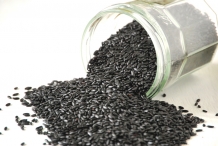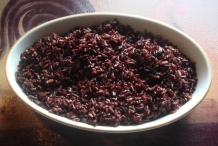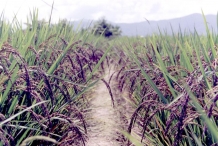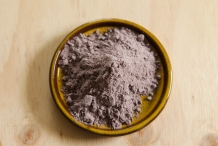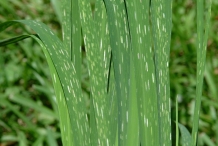| Black rice Quick Facts |
| Name: |
Black rice |
| Scientific Name: |
Oryza sativa |
| Origin |
Rice is domesticated in India and brought to China by 3,000 B.C. It was cultivated by 2,000 years ago in Babylon and the Middle East, and spread to the Europe during medieval times. |
| Colors |
Whitish yellow to brown or blackish |
| Shapes |
Ovate or elliptic to cylindrical, 5 to 7 mm |
| Health benefits |
Full of Antioxidants, Protects Heart Health, Can Help Detoxify the Body, Good Source of Fiber Which Improves Digestive Health, A Naturally Gluten Free Grain |
Black rice still is comparatively uncommon in the United States, yet 21st century food researchers are finding that, with regards to nutrition, black rice has numerous health advantages. In historical China, nobles took possession of every grain of the “forbidden rice,” and common Chinese people weren’t permitted to have or even consume black rice. Black rice was initially introduced to the United States in 1995. Presently, you can purchase it at organic food markets, but because people discover as well as demand it, black rice will likely become more widely accessible at supermarkets as well as restaurants.
Health Benefits of Black Rice
Among the thousands of rice variety, the black rice, also referred to as Forbidden rice or even purple rice, is recognized as among the varieties with all the greatest nutritional value. It has 18 amino acids, minerals and vitamins like copper, iron, zinc and carotene.Listed here are some health advantages of black Rice
1. Full of Antioxidants
The bran hull of black rice, the actual outer layer of the rice grain, consists of among the greatest quantity of a antioxidant anthocyanin present in any known food.
Black rice features a deep black or even purple color, that is a sign of the higher antioxidant properties, much like how deeply colored anti-oxidant berries like blueberries, raspberries, as well as cranberries appear.
Sources reveal that the anthocyanin content of black rice is greater than any other grain, which includes brown rice, red rice, red quinoa, or any other colored whole grain varieties.
Anthocryanin has the capacity to assist in preventing an array of common yet significant health problems in accordance with clinical studies which have looked at the advantages of this particular antioxidant.
Anthocyanin antioxidants have been linked with: preventing cardiovascular disease, protecting against cancer that may be brought on by free radical damage, enhancing brain function, decreasing inflammation and much more.
Nutrition are lost from whole grains once the outer layer, the hull and bran, are eliminated. Just whole grains including all of their naturally occurring parts retain their anti-oxidants, vitamins, minerals, and fiber. White rice, along with other refined grains, lose these beneficial properties throughout the milling process.
While whole grain brown rice as well as red rice also include advantageous anti-oxidants, only black rice consists of anthocyanin. Additionally, black rice also includes essential anti-oxidant Vitamin E, that is beneficial in maintaining eye, skin, and immune health along with other essential functions.
2. Protects Heart Health
Research indicates that black rice reduces dangerous atherosclerotic plaque formation within the arteries, that is essential for keeping arteries clear as well as avoiding heart attacks as well as stroke.The particular anthocyanins phytochemicals present in black rice assist to maintain healthy cholesterol levels by reduction of total cholesterol, LDL “bad” cholesterol, and total triacylglycerol concentrations. These are 3 factors commonly involved in cardiovascular disease (3).
Considering how common heart disease is within nearly every western developed nation today, this is a good reason why consuming healing foods like black rice is so essential.
3. Can Help Detoxify the Body
Studies have indicated that consuming black rice may help detox the body as well as cleanse the liver of harmful toxic build-up thanks to the rice’s high antioxidant content.
In a current animal study, the anti-oxidant status of blood, the liver, and one of the main arteries, the aorta, were examined in rabbits which were either fed refined white rice or even black rice.
Results demonstrated that the rabbits fed black rice experienced less oxidative stress (also known as free radical damage), included more antioxidants within their blood, experienced detoxification within the liver, and in addition had decreased plaque build-up within the arteries.
The nutrients present in black rice assist the body to lessen inflammation and also to cleanse the entire body of harmful substances that will give rise to a variety of situations.
4. Good Source of Fiber Which Improves Digestive Health
Black rice along with other whole grain rice varieties- just like wild, red, or brown rices- have similar quantity of fiber, with approximately 2-3 grams per half cup serving. The fiber in black rice helps you to avoid constipation, bloating, along with other unwanted digestive symptoms. Fiber binds to waste and toxins in the digestive tract, assisting to pull them out and also to contribute to frequent bowel function.
The dietary fiber present in black rice may also significantly enable you to feel full after consuming and also to stay satisfied a bit longer time in between meals, possibly aiding in weight reduction.Research has discovered that a diet full of dietary fiber from whole grain rice types is protecting towards obesity, heart disease, diabetes, as well as digestive disorders just like irritable bowel syndrome (IBS). It is because fiber has got the essential job of clearing the entire body of toxins, assisting to decrease inflammation and also to clear the arteries since it eliminates waste as well as plague through the body. Black rice may also help avoid or even cure cases of diarrhea, since fiber adds bulk in your stool.
5. A Naturally Gluten Free Grain
Just like other rice varieties, black rice naturally consists of no gluten, the protein present in all wheat, rye, and barley products. It’s approximated that 1 in 7 individuals are responsive to gluten- whether they are aware of it or not- but still test negative for Celiac Disease.After consuming something along with gluten in it, those with a gluten sensitivity suffer most of the same symptoms as individuals with Celiac Disease (a confirmed allergy to gluten), which includes bloating, constipation, diarrhea, nutrient deficiencies, as well as an increased risk for developing leaky gut syndrome. Consuming black rice instead of not only refined grains and processed flour products, but additionally all wheat, barley, and rye that contains foods- even those that are whole grain- might help remove digestive problems related to consuming gluten for most people.
6. Helps Slow Down Absorption of Sugar in the Blood, Helping to Prevent Diabetes
Research indicates that when it comes to the chance of developing diabetes and also obesity, consuming whole grains is a lot more beneficial as well as preventative compared to consuming refined carbohydrates. When compared with consuming processed carbohydrates that are stripped of the fiber, antioxidants, along with other nutrition which help to slow down the absorption of sugar within the blood stream, black rice is really a much healthier alternative.
Black rice has the whole bran of the grain where the fiber is kept, and fiber has the capacity to help glucose (sugar) from the grain to be absorbed through the body over a extended period of time.
When researchers analyzed white and brown rice consumption in relation to type 2 diabetes risk, they discovered that white rice was more prone to contribute to insulin resistance as well as diabetes risk.
The substitution of whole grains, which includes brown or black rice, instead of white rice, white bread, pasta, and sweetened cereals may lower the chance of type 2 diabetes along with other problems, along with keeping the weight under control as well as your energy levels balanced.
7. Better at Preventing Obesity than Refined Grains
It is crucial for those along with pre-diabetes, diabetes, or any other forms of metabolic syndrome as well as insulin resistance to consume 100% whole grains, instead of processed “white” types which lack fiber.Exactly the same can probably be said for those who have a problem with slimming down, since the fiber as well as nutrients in whole grain rice helps you to shut off hunger signals as well as helps prevent overeating. Research has revealed that whole grain rice types might help avoid insulin resistance which is associated with an elevated risk for obesity.
8. Anti-inflammatory Properties
Black rice consumption have been related to reduces in inflammatory substances, particularly reactive oxygen species as well as aortic malondialdehyde, and raises in anti-inflammatory mediators, like superoxide dismutase. Increases in inflammation are related to disease and conditions like atherosclerosis, arthritis, cancer, aging and allergies.
9. Prevents Atherosclerosis
Black rice features a powerful impact on the heart’s health. All of the nutrition retained within this variety assist in the protection against high blood pressure levels and plaque formation within the heart.
Atherosclerosis, represented by hardening of the artery walls, is really a cardiovascular disease affecting many. Eating black rice is considered to cut deaths significantly from such causes. The rice also enhances heart outcomes by reduction of LDL cholesterol as well as total cholesterol.
10. Black rice and weight loss
In China, black rice is becoming common as weight reduction food. Very little scientific evidence is accessible. However this result can be related to high fibers contained in black rice which provides sense of full stomach as well as decreases craving for food. High fiber as well as anthocyanin also assist in reducing absorption of cholesterol. Animal study has additionally shown that black rice extract reduced serum triglyceride levels, decreases platelet hyper activity and helps prevent weight gain.
11. Black rice for gastrointestinal health
Like brown rice, black rice provides higher dietary fibers and is also great for your gut. It facilitates bowel motions and helps prevent constipation. Higher fiber also helps prevent assimilation of toxic materials in intestine and results in their elimination from body.
12. Black rice good for eyes
Anthocyanins safeguard eyes from degenerative problems of eye. A diet full of black rice may decrease chances of development of cataract or diabetic complications associated with vision.
Latest research point to preventative as well as curative effects of anthocyanins on impaired vision. Animal research indicates that anthocyanins may be used in management of opthalmological diseases just like myopia and glucoma.
13. Skin benefits of black rice
Antioxidant nature of black rice is effective in safeguarding skin. Black rice helps prevent skin from damage by pollutants or sun. It helps prevent aging of skin as well as decreases signs of aging such as wrinkles, dark spots as well as fine lines. Black rice provides antioxidants along with other proteins to skin which will help in restoring skin elasticity and maintain firmness. Try out a few homemade preparation of black rice for the skin –
- Use black rice flour for making a facial mask. Mix dried black rice powder along with honey and also use this in your face. Leave this for 20-30 minutes before you decide to wash face along with cold water. This particular black rice facial would moisturize the face.
- Boil ½ cup of black rice along with 4 cups of water for 10 minutes. Let it cool as well as rice to settle down. Sieve to eliminate black rice water. Soak paper towel or even napkin within this rice water and put it over the face for 10-15 minutes.
- Grate some potatoes finely as well as crush to have potato starch. Include some black rice flour to the juice and mix well to create smooth paste. Apply to the face for 10-20 minutes.
14. Black rice for hair growth
In China, homemade fermented black rice water is utilized to wash hair. This black rice water provides anti-oxidants and nutrition for protection of scalp and hair. It really is considered to help make your hair smooth and glossy. Also try homemade black rice shampoo made out of black rice water and aloe vera gel for safeguarding hair damage. Black rice provides biotin, Vitamin B along with other proteins necessary for hair growth. It safeguards hair damage from wind and sun. Today numerous hair formulations can be found in market with black rice extract. This particular evident uses black rice nourishing wine made out of black rice, mulberry, Chinese angelica, dried rehmnnia root as well as yellow rice wine particularly ratio for hair nourishment as well as growth.
15. Asthma
The anthocyanins in black rice have shown to fight free-radicals within the body and particularly the ones that induce inflammation within the airways and liable for mucous secretion related to asthma. This in no way is supposed to replace any kind of asthma medicine you presently take but tend to work as an adjunct to something to assist manage asthma exacerbations.
https://www.youtube.com/watch?v=mGGVFbd0dI0
History of Black Rice(Forbidden Rice)
Black rice is usually known as “forbidden rice” due to its long and fascinating history. Since you probably know, all rice varieties really are a considerable and important crop within the diet of nearly every Asian population, and also have been for centuries. In China, black rice is known for being great for the kidneys, stomach and liver since ancient times.
Thousands of years ago in ancient China, noble Chinese men took possession of each and every grain of the black forbidden rice, banning its usage among anybody who wasn’t royalty or even very wealthy.
The crop was just cultivated in restricted amounts, closely monitored, and also restricted to just the highest elite class.The common Chinese people weren’t permitted to grow or even consume this particular black forbidden rice, that resulted in its unique name which it still carries with it today.
Black rice was really only first introduced to the United States within the 1990’s, even though it’s been enjoyed in other parts of the world for a lot of more years. Today it’s no longer banned, however is developed in comparatively small amounts particularly when compared with other kinds of widely accessible rice varieties.
Where to Purchase Black Rice
The popularity of black rice and knowledge about its numerous health advantages is increasing in western nations, which includes in the U.S, however it still remains significantly less well-known compared to less healthy white rice and also similar brown rice.At the moment, you are able to likely find it in many health food stores and large gourmet food markets, along with Asian supermarkets. The hope is that as more people find out about black rice’s benefits as well as demand it, black rice will likely be more widely accessible at larger chain supermarkets as well as restaurants.Since the mentioned health advantages of black rice are found within the bran of the rice, you usually wish to buy 100% whole grain black rice. You can be certain you’re obtaining the correct kind by checking the ingredient label and looking for the words “whole black rice” as the first, and ideally the only, ingredient on the list.
How to Cook Black Rice
Black rice comes from exactly the same plant family as other colored rices and includes several varieties, like Indonesian black rice and Thai jasmine black rice. The differing types of black rice include virtually identical health advantages and all have got a mild, nutty taste which is similar to the taste more familiar brown rice.Since it is unrefined as well as denser compared to white rice, black rice will take longer to cook. The best results may be accomplished by first soaking your black rice for around one hour just before cooking it, yet ideally for many hours.If you’re able to plan ahead of time as well as soak your rice, you’ll reduce the amount of cooking time needed and in addition make the nutrients within the rice more absorbable.
After soaking your rice, wash the rice clean and then put it on the stove top along with two cups of water for each one cup of rice. Boil the rice for around one half hour in case you did soak the rice, and for one hour if you didn’t.Look at the texture of the rice after this time to see if it’s chewy as well as cooked through; if not, keep boiling till it gets to the texture you’re searching for.
Concerns with Black Rice
Even though black rice consists of beneficial nutrition, grains are generally most appropriate when they’re consumed moderately as part of an otherwise healthy as well as well-rounded diet.Although black rice does include more fiber as well as anti-oxidants compared to refined grains or carbohydrate foods, all grains still have the cabability to effect blood sugar levels, therefore keeping track of portion sizes of all grains is usually advisable.It may also help to consume grains just like black rice with a source of healthy fat and a few protein. This further delays the time it will take the carbohydrate’s sugars to impact blood sugar levels.
Ancient, whole grains just like black rice can play a healthy part in someone’s diet, once they are conscious of how much they consume and in addition be sure to get lots of filling protein as well as healthy fats from other food sources which are better suppliers of the essential macro-nutrients.
Comments
comments



